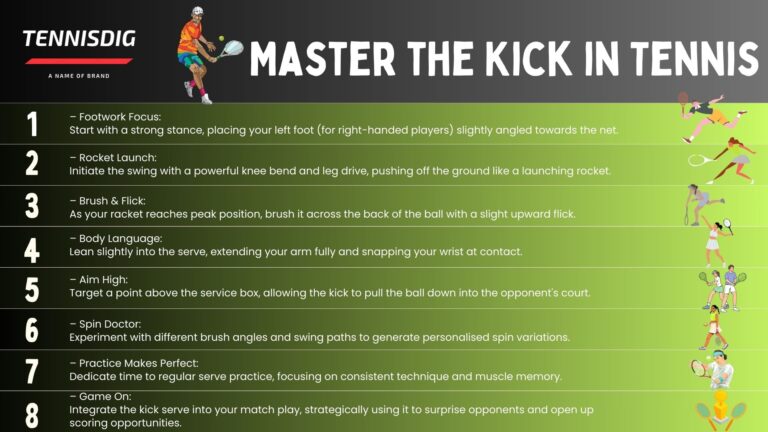Tennis, a game of skill and power, is enhanced by various serves that keep opponents guessing. The enigmatic kick serve is one of these serves, a tactic that adds depth and intricacy to a player’s repertoire. Let’s explore in detail what is a kick serve in tennis to discover its scientific mysteries and avoidable errors.
A kick serve needs a precise combination of skill and timing. The primary goal is to generate significant topspin by brushing the rear of the ball. The necessary spin is produced by this brushing motion in conjunction with a prominent upward swing path. The contact point, which is slightly to the side and above the center of the ball, enables efficient spin creation.
The Science of the Kick Serve
The toss, racket route, and body placement are all critical components of a kick serve. A higher toss, slightly to the dominant side, allows for a more vertical swing path, allowing the racket to brush against the back of the ball efficiently. Furthermore, wrist pronation at impact improves spin and control over the serve.
What is a Kick Serve in Tennis?
The kick serve, often known as the topspin serve, is a well-known serving method in tennis. When performing a kick serve, players purposely strike the ball high, placing the contact point well over the net. This cautious technique reduces the possibility of unforced errors, making it an excellent alternative for second serves.
The kick serve transmits a forward spin when landing on the tennis court, forcing the returner to retreat or reposition to the side. Notably, kick serves go slower, giving the opposing player more time to strategize and prepare for their return.
The Benefits of the Kick Serve
It is essential to learn what is a kick serve in tennis to reap its various advantages, making it an essential part of a player’s strategic movements. Its strong bounce and extra spin may put opponents in awkward situations, forcing them beyond the baseline and interfering with their rhythm. This service also has a more significant margin for mistakes because of its prominent trajectory, which reduces the possibility of double faults.
Improving Your Kick Serve
Mastering the knowledge of what is a kick serve in tennis takes commitment and consistent practice. Begin with the grip, establishing a continental or Eastern backhand grip for improved control and spin creation. Next, fine-tune the tossing action to achieve consistency in height and placement.
Focus on the swing route, focusing on a smooth upward action while keeping adequate body rotation. During the serve, the weight shift from the rear foot to the front foot is critical for power and accuracy. Repetitive training focusing on the kick serves to aid in developing the necessary muscle memory.

Common Errors to Avoid
Despite its efficacy, completing a kick serve may take time, resulting in frequent mistakes. One standard error is insufficient racquet head speed, which results in insufficient spin. Over-rotation of the body or an incorrectly timed toss can also sabotage the desired consequence. Patience and patience are essential in correcting these mistakes via constant practice.
Using the Kick Serve in Your Game
Using the kick serve tactically during a game improves a player’s overall game strategy. Changing up your serves between flat, slice, and kick keeps your opponents guessing and prevents them from getting into a pattern. The kick serve may provide pressure and break an opponent’s momentum when used at critical times.
The Bottom Line
The kick serve is a tribute to the complexities of tennis, combining technique and strategy. Its ability to perplex opponents and dominate play makes it a significant advantage for players of all skill levels. Mastering the art of learning what is a kick serve in tennis offers up a world of options on the court, pushing one’s game to new heights with devotion and practice.

